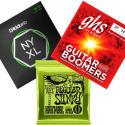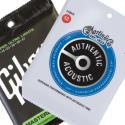Guitar String Gauges Explained By Our Guitar Guru
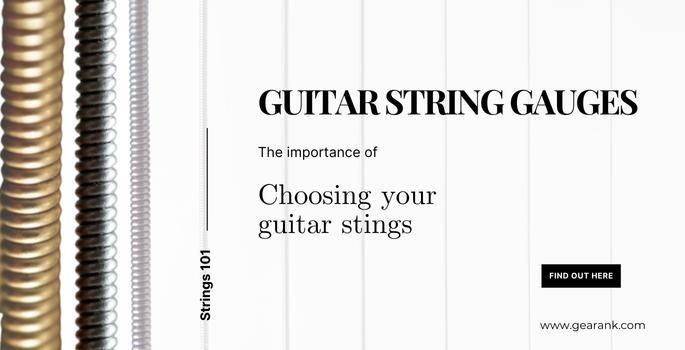
Are you curious about the different guitar string gauges? Do you want to know how string gauges affect playing feel and tone?
Here, I'll help you better understand the pros and cons of changing the gauge of your guitar strings. And how these changes can impact your instrument and overall playing experience.
In this article, you'll learn...
-
String gauge basics
-
Does string gauge matter?
-
Choosing the correct guitar strings
I'll also share tips and experiences to help you pick the correct string gauge.
Guitar String Gauges Explained
Guitar string gauges refer to a guitar string's thickness, typically measured at 1/1000th of an inch.
Most commonly, each string set's name is based on the thickness of the high E string, with 9-gauge, 10-gauge, or 11-gauge strings being the most common. These are also known as light, medium, or heavy.
For example, a 10-gauge set has a 0.010" thick high E string.
It's also worth noting the variations depending on the brand. So, double-check if the brand you want has the string gauge you prefer.
A G string in one 9-gauge set might be 0.016 on brand X and 0.015 on brand Y.
Furthermore, string thickness plays a significant role in playability and tone. These differences might seem small, but you would be surprised to know how a few fractions of an inch can alter your playing experience and tone, as you will soon find out.
Does String Gauge Matter?
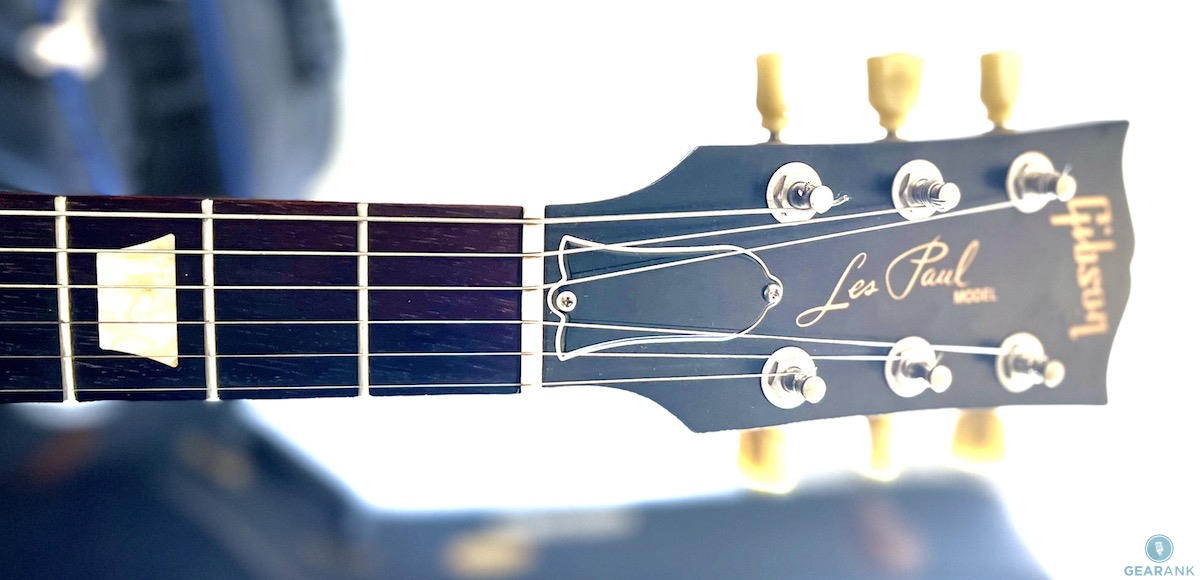
Yes, the guitar string gauge does matter!
Changes in string mass and tension will impact the playing feel of your guitar and affect tone.
Thinner strings apply less tension, which generally makes them easier to play. So, if you want to make your guitar easier on the hands, you should go for light gauge sets.
But there is a downside: light gauge strings are flimsy to handle and can sound a bit thin and trebly.
The thicker the string gauge is, the more tension it applies on the neck and bridge as you tighten the strings up to pitch.
This is why heavy gauge strings have a fuller sound but are stiffer and require more effort to fret, strum, and pluck.
There are limits to how much string tension a guitar can handle. This is why you need to be sure that your guitar can handle the extra stress of heavier gauge strings before switching.
What Are The Factors To Consider When Choosing String Gauges?
Before buying new string gauges for your electric guitar, here are some essential factors you must consider before placing an order.
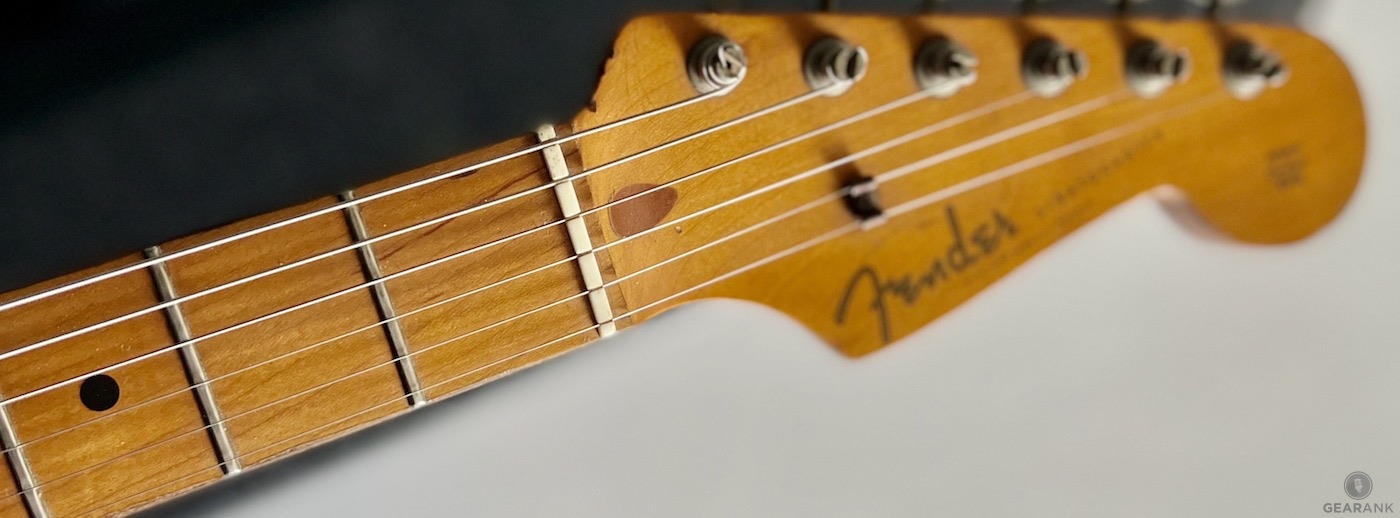
Ease of Play
Easy playability is one of the most common reasons guitarists change their string gauges, especially beginners.
- Easy playability is why light gauge sets are so popular. Thinner and lighter strings have less tension, making the strings easier to bend and fret. This lets you play guitar with less effort. With less tension, you can fret and move your fingers faster, making light gauge sets ideal for quick leads and rhythmic phrases. So, if easy playability is your priority, light gauge sets are your best choice.
- In contrast, thicker and heavier strings have more tension, requiring more finger strength to fret and bend. This means more effort in each note that you play. But it's not all bad because thicker strings are more tactile. They don't feel like thin threads that can easily break. This allows for more aggressive, expressive, and accurate playing. This tactile feel is the main reason I prefer medium gauge sets over light gauge, and plenty of experienced musicians share my preference. Go for medium to heavy gauge sets if you want strings that you can feel and give you a bit of a fight as you play.
Tone
String thickness can influence the resulting sound of your guitar. For starters, thicker strings are louder than thinner strings. You can get more volume with less effort if you choose a heavy set.
Thick strings create more low-end frequencies (described as having a darker tone) that match the weight of the strings. You can add warmth to your sound with thicker strings.
Thinner strings have a bright-lighter sound. There's more treble to the light tension of these skinny guitar strings. They also produce excellent clarity for a cleaner tone. Light strings favor the middle and treble frequencies.
Specific string gauges are commonly associated with different styles of music. For example, a light gauge is standard for country music, while a heavy gauge is for metal. While these are helpful guidelines, you can play any genre with any gauge.
Tuning Stability
The thickness of the strings will influence tuning stability. Lighter strings with less tension are more prone to going out of tune. This is especially true for those who play aggressively.
The added tension of thicker strings makes them more resilient to tuning issues. Heavy strings are particularly beneficial if you're drop-tuning your strings. Down tuning loosens the guitar strings, so a heavier gauge compensates for the lost tension.
Tension Handling
Guitars are designed and set up with a specific string tension range. So any big jumps in tension and damage, if not break, your guitar.
This is why it is best to do string gauge changes in increments, i.e., don't jump to heavy gauge from light gauge.
This is especially true with older and more fragile acoustic guitars.
To be safe, contact the manufacturer of your guitar if you're planning on switching to a heavier set.
Scale Length
The length of the guitar neck, also known as scale length, is the distance from the bridge to the nut. Scale length isn't standardized and varies from brand to brand (and guitar to guitar).
A shorter scale length puts less tension on your strings, so they can balance out some of the extra tensions of medium to heavy gauge sets.
On the other hand, a longer scale length puts more tension on the strings, as they have more to stretch. Light gauge strings can offset some of the stress required by the longer neck.
Choosing The Correct Guitar Strings
From playing style to tone, there are a lot of factors that can affect what string gauge you choose. In this section, I'll examine the most common string types and their uses.
This section is focused primarily on electric guitar strings.
1. Extra Super Light Gauge Strings
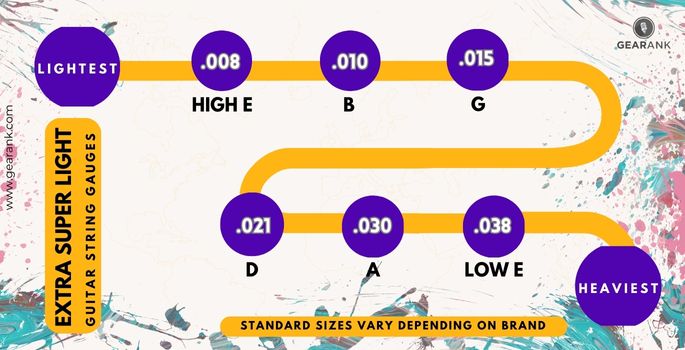
This is the thinnest set that you can get for electric guitars. These typically have an 8-gauge at the top, with the low E measuring just 0.38.
Extra Super light strings are incredibly easy to fret. You can press them down and bend them easily, so even beginners will feel comfortable. They're also perfect for fast playing because of the little resistance.
But if you're an experienced guitar player, you might find these strings too thin. They are so thin that they feel like fragile threads that can easily break. This won't handle aggressive pick attacks well and are prone to detuning.
As for tone, this set produces the brightest trebly tone among the main sets. It can be a bit too thin sounding for some.
Notable Guitarists who have used Super Light Gauge Sets: Jeff Beck, Jimmy Page, and Billy Gibbons.
2. Super Light Gauge Strings
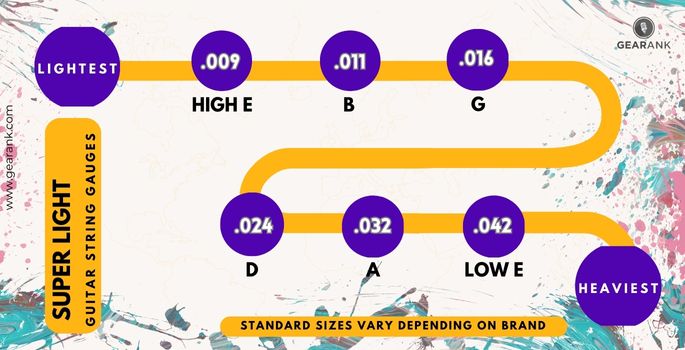
Super-light electric guitar string set is a step up from the extra-super-light sets. But it still is considered thin with its 9-gauge high E string, and low E measuring at just 0.042.
This set is very easy on the hands, and is popular among students and experienced musicians who want something lighter than the common gauge 10 set, but not too thin like the 8 gauge set.
Pressing on the strings, bending, tapping, and sliding are a breeze with this set. They are smooth to the touch, but not too fragile feeling.
This set provides the most comfortable playing feel without being overly thin. But for those used to thicker sets, this can still feel slacked and frail. Expect some tuning issues when freshly installed.
This set produces a bright, trebly sound with good clarity.
Notable Guitarists who have used Super Light Gauge Sets: Jeff Beck, Jimmy Page, and Billy Gibbons.
3. Light Gauge Strings
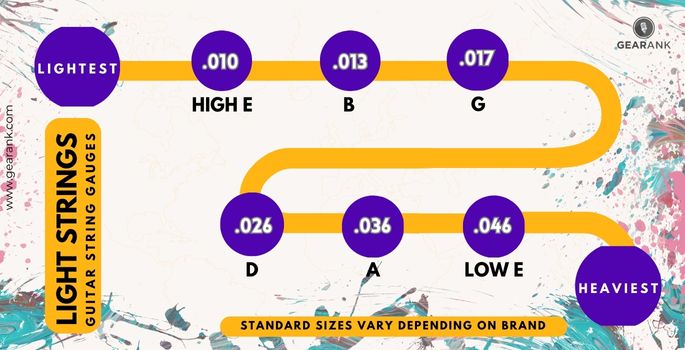
Light gauge strings tend to be 10-gauge sets. They are slightly thicker than super-light but have low tension for easy movement and bright tone.
This is the most popular among the gauges because it is still easy to play without feeling too thin and flimsy.
Light gauge sets are widely used across different musical styles, from pop to blues to rock. They have excellent clarity and a cheerful tone, great for bell-like chords and fast melodic lead lines.
Speaking of fast, these strings appeal to technical guitar players who are after speed. The low tension means you can bend and fret the strings quickly while retaining clarity. Light strings are easy to manipulate for blues that lean towards string bend. However, they will lack some warmth.
Notable Guitarists who have used Light Gauge Sets: Eddie Van Halen, Frank Zappa, Randy Rhoads, Angus Young, and Mark Knopfler.
4. Medium Gauge Strings and Hybrid Gauge Strings
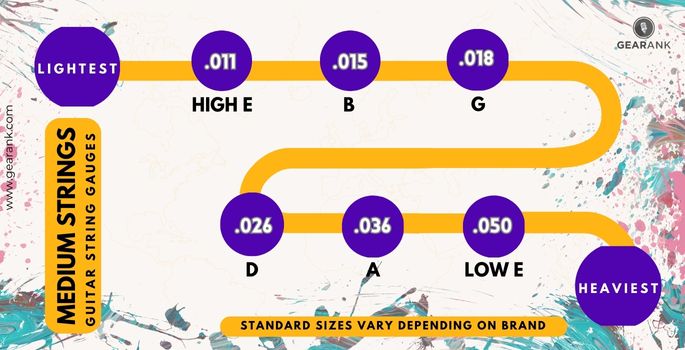
Medium strings introduce a little more tension to the guitar. A medium gauge typically refers to 11-gauge sets. They're versatile thanks to some weight at the lower end and a light high end.
Medium strings are prevalent. Lots of your favorite guitarists have used them, and you can find them across genres. They're particularly popular for rock, especially if you play lead guitar. You can get that quick movement needed for a solo.
Medium strings also appeal to blues players. You might not have the easy bend of a light string, but you have more warmth and better vibrato.
There are Hybrid or Custom gauge sets that tend to be counted as medium strings. These sets blend the highs of a light set and the lows of a heavy set. The highs have that easy movement you need for solos, while the thicker low strings stay tuned for power chords. They're versatile and comfortable to play with.
Notable players who have used 11s: Slash, James Hetfield, Joe Bonamassa.
5. Heavy Gauge Strings
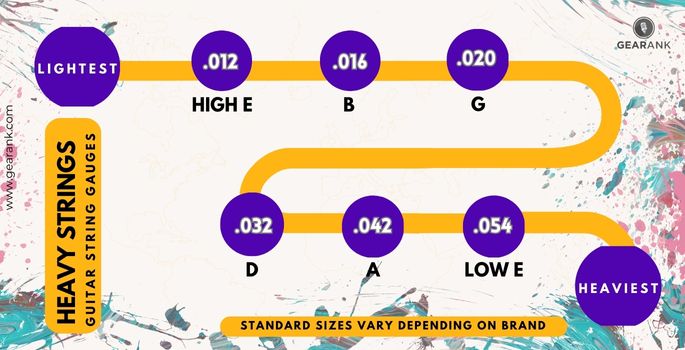
Thick strings, or heavy strings, are 12-gauge and upwards. If you want to try drop-tuning, you'll need a set of thick strings. Anything too light will buzz and fall out of pitch.
You'll need heavy strings if you want lots of warmth and low frequencies. They're most common in metal, but rock and jazz guitarists also use them. They aren't as versatile as other types. However, a talented guitarist can adapt even an extra-thick gauge to different genres.
The weight and tension of thick strings make them harder to bend. It is possible, but you'll need to practice a lot.
While heavy strings might not be prevalent for electric guitarists, they're famous for acoustic guitars. It's an easy way to get volume and resonance.
You should change the action or string height if switching to thick strings from a light set. The thicker strings will sit lower, making them more likely to hit the fret in front, leading to a fret buzz.
Notable players who have used 12s: Stevie Ray Vaughan, Malcolm Young, and Pat Martino.
Tips
-
Using medium-heavier gauge strings makes sense for blues guitarists. So if you're into some blues and rock, this is for you. However, if you're more into pop, jazz, prog, or other fast and bright genres, you'll find that changing to a lighter string gauge is better.
-
It is worth noting that some guitarists use alternate tunings like drop D, drop C, or E♭and guitars with shorter scale length to compensate for the extra tension of heavy gauge sets. You can utilize this method to benefit from the full sound of thick gauge sets while reducing some of the stiffness of the strings. This same principle applies to bass guitar strings.
-
For best results, go to your nearest guitar tech and have him set up your electric guitar and change its strings. This way, string action will be properly set up to accommodate the change in tension.
-
If you're seeing some players change their guitar onstage, know those aren't just for show. They switch guitars to utilize different string types and tunings for creating different sonic textures.
Conclusion
Now you have a clearer picture of the different guitar string gauges.
Following the guidelines above, you can confidently choose a string gauge that suits your preference.
Let your fingers and ears guide you in choosing the best strings.
Now, onto placing your guitar string orders.
Frequently Asked Questions
What Is String Gauge Best for Acoustic Guitars?
While electric guitars perform best with lighter gauge strings, acoustic guitar strings come with medium gauge sets by default.
This is because string resonance is more important for the tone and projection of acoustic guitars.
In addition, heavier string gauges also provide tuning stability and more sustain, which is vital for an acoustic instrument.
Are Thinner or Thicker Strings Better For Metal?
A thicker electric guitar string set is ideal for the hard-hitting riffs often utilized in metal. The higher tension allows the strings to survive heavy picking. It also produces a louder, warmer tone with plenty of lower frequencies, ideal for metal, rock, and similar styles.
Contributors:
Jerome Arcon - Co-writer and Illustrations (Image Credit)




